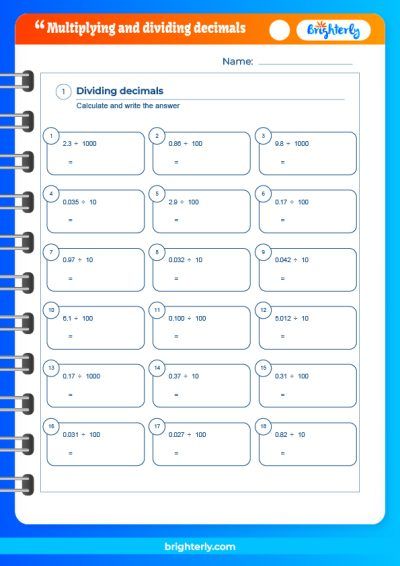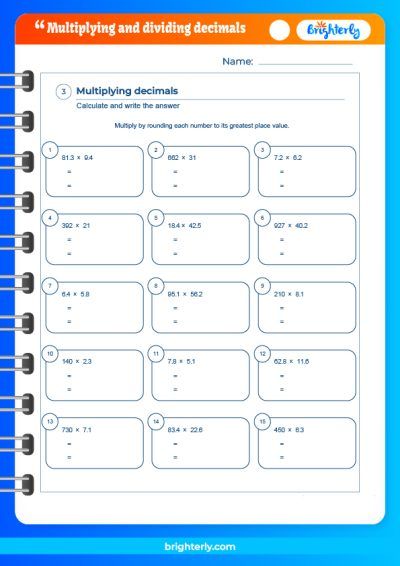Multiplying Decimals – Definition with Examples
Updated on January 11, 2024
In the vibrant world of mathematics that Brighterly aims to illuminate for children, decimals hold a special place. These numerical expressions that incorporate fractions of whole numbers permeate various facets of our lives – from checking the time to managing money or even baking a cake! As such, understanding how to work with decimals, especially multiplying decimals, becomes an indispensable part of a child’s mathematical toolkit. At Brighterly, we believe in unravelling the intricacies of decimals in an enjoyable, engaging manner, making learning a delightful experience. This guide will provide a comprehensive look at multiplying decimals, breaking it down into manageable steps and enhancing understanding through examples.
Introduction of Multiplying Decimals
Decimals are a fundamental part of our everyday life. We encounter them in our finances, measurements, and even while calculating the time. Therefore, understanding how to perform arithmetic operations like multiplying decimals is an essential skill. Just like you multiply whole numbers, you can also multiply decimals to get the product. But with decimals, there’s an additional step of positioning the decimal point in your answer, which we’ll learn about in the next sections.
How to Multiply Decimals?
Multiplying decimals may seem challenging at first, but it’s fairly straightforward once you understand the basic principles. The general rule for multiplying decimals is to ignore the decimal point initially and multiply the numbers as if they were whole numbers. Afterward, count the total number of digits after the decimal point in the original numbers and place the decimal point in your answer so that there are the same number of digits after it.
Multiplying Decimals with Whole Numbers
Multiplying decimals with whole numbers is not too different from regular multiplication. The process begins by ignoring the decimal and multiplying as if both numbers were whole. Afterward, you place the decimal point in your product by counting how many numbers are after the decimal in your original decimal number.
Multiplying Decimals by 10, 100, and 1000
When you multiply a decimal number by 10, 100, or 1000, the decimal point moves to the right by as many places as there are zeros in the number you’re multiplying by. So, if you’re multiplying by 10, move the decimal point one place to the right; if by 100, two places, and if by 1000, three places.
Multiplying Two Decimal Numbers
Multiplying two decimal numbers follows the same rule as above. Ignore the decimal points initially and multiply the numbers as if they were whole numbers. Then, count the total number of digits after the decimal points in the original numbers. Finally, place the decimal point in your product so that there are the same number of digits after it.
Multiplication of Decimals with Whole Numbers
When multiplying a decimal with a whole number, treat the decimal as a whole number and perform the multiplication. After that, insert the decimal point in the product, ensuring that the number of digits after the decimal in the product is equal to the number of digits after the decimal in the original decimal number.
Multiplication of Decimals with Decimals
Multiplying decimals with decimals follows the general rule of multiplying decimals. You ignore the decimal points initially and multiply as if both numbers were whole numbers. Afterward, count the total number of digits after the decimal points in the original numbers and place the decimal point in your answer so there are the same number of digits after it.
Solved Examples on Multiplying Decimals
Let’s look at a few solved examples:
Example 1: Multiply 0.5 by 4
- Step 1: Ignore the decimal and multiply as if both numbers were whole (5*4=20)
- Step 2: Count the number of digits after the decimal point in the original number (one digit after the decimal in 0.5)
- Step 3: Place the decimal point in your answer so there’s the same number of digits after it (Result is 2.0)
Practice Questions on Multiplying Decimals
Now, it’s your turn to practice! Try solving the following questions:
- Multiply 0.6 by 3
- Multiply 0.75 by 4
- Multiply 0.12 by 0.3
At Brighterly, we believe that practice is the key to mastery. That’s why we invite you to explore our multiply decimals worksheets, where you can find an array of additional practice questions, complete with answers.
Conclusion
As we conclude our exciting journey into the world of decimal multiplication, it is important to remember that practice is key. Just as Brighterly is always there to light your path towards mathematical mastery, so should you be relentless in honing your skills. Revisit the principles, go through the examples again, and try out as many practice problems as you can. Remember, each step you take gets you one step closer to becoming a decimal multiplication wizard!
Frequently Asked Questions on Multiplying Decimals
How do I multiply decimals?
Multiplying decimals is a straightforward process when you follow the necessary steps. Begin by ignoring the decimal points and treat the numbers as if they were whole numbers. Multiply them accordingly. After this, count the total number of digits that follow the decimal points in the original numbers. Your answer should have the same number of digits after the decimal point.
For example, if you’re multiplying 0.45 by 0.3, you would initially treat them as 45 and 3, giving you 135. However, there are two digits following the decimal point in 0.45 and one digit following the decimal point in 0.3. Therefore, there should be three digits following the decimal point in the answer. This gives us the final answer of 0.135.
What is the difference between multiplying whole numbers and decimals?
While the basic process of multiplication remains the same, there is an additional step when multiplying decimals. This step involves calculating the correct position of the decimal point in your answer. You must count the total number of digits that follow the decimal points in the numbers you are multiplying, and your answer should have the same number of digits after its decimal point.
Can you provide more examples of multiplying decimals?
Of course! Let’s try multiplying 0.65 by 3. We start by ignoring the decimal point and treating the numbers as if they were whole, giving us 65 x 3 = 195. Then, since there are two digits following the decimal point in 0.65, our answer should also have two digits following the decimal point. Therefore, the final answer is 1.95.






